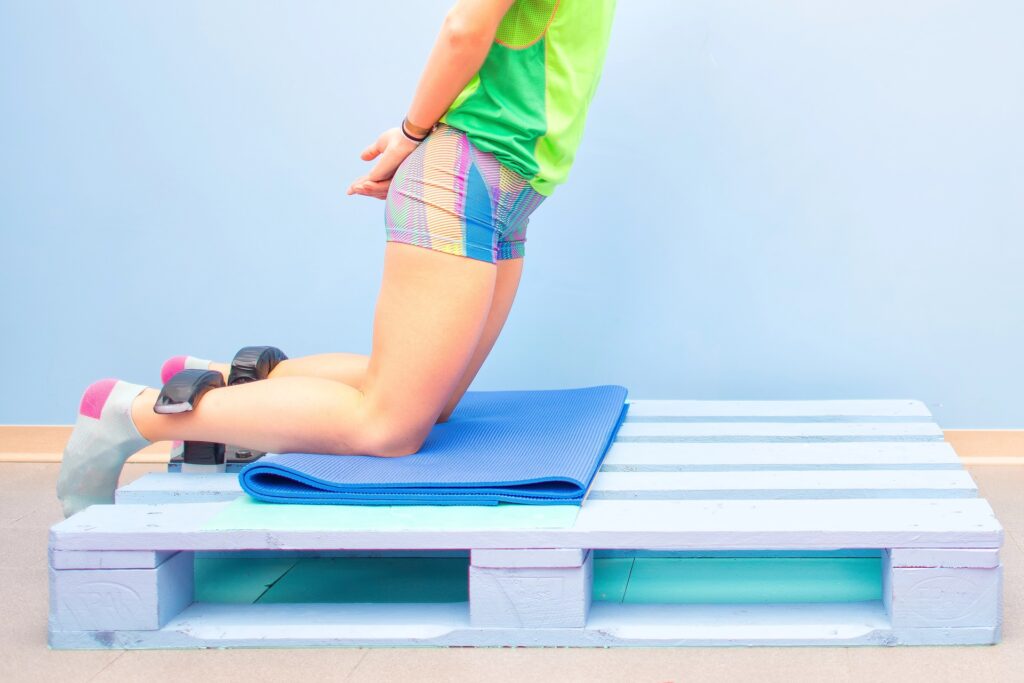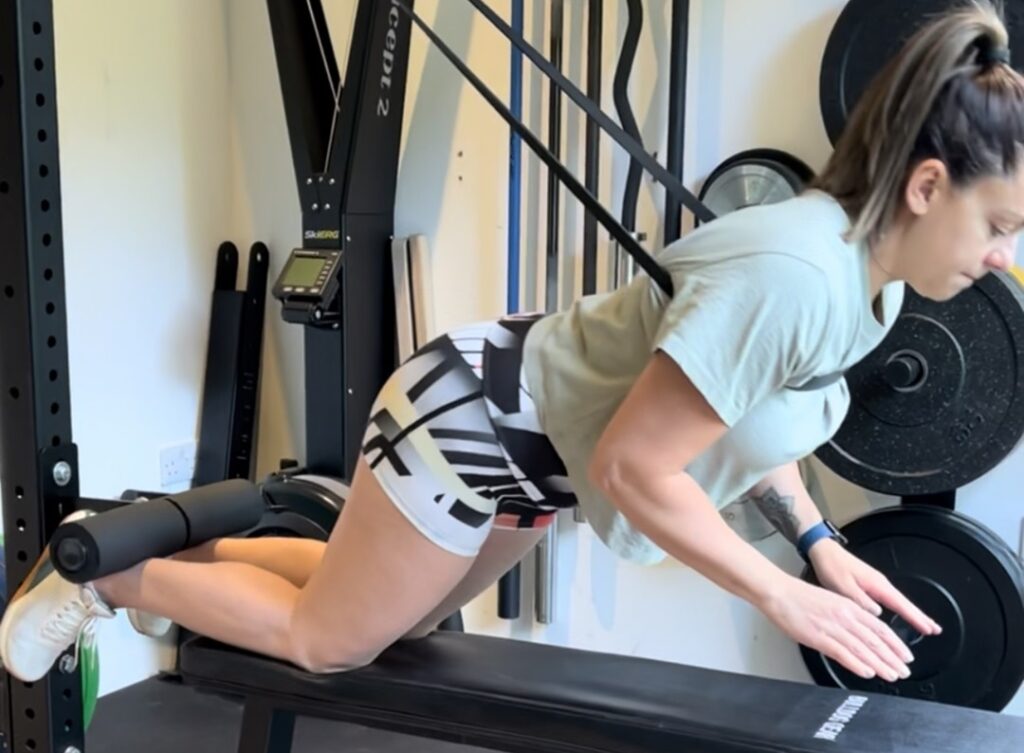How many times a week should you do the Nordic curl?

Share This Post
Nordic Curl Exercise Overview
The Nordic curl attachment allows you to easily perform the Nordic hamstring curl. It is a go-to move for anyone looking to strengthen their hamstrings. This bodyweight exercise needs hardly any gear and is a favourite for its strength-building and injury-preventing benefits.
How to Do It Right
To master the Nordic curl, you need to anchor your feet or heels under something solid or use a special attachment. Start on your knees, keeping your body straight from shoulders to knees. Slowly lower yourself toward the ground, using your hamstrings to control the drop, then pull yourself back up to the starting spot.
Forte Fitness new and redesigned Nordic curl attachment, is fully designed and manufactured in the UK. Featuring extra thick 75mm foam for added comfort, simply add this Nordic bar attachment to your rig and start working to strengthen your hamstrings, glutes, and core.
The Nordic curl attachment is a must-have for anyone looking to build strength and power in their legs and core through Nordic curls, feet-anchored sit-ups, and more. We highly recommend incorporating it into your workout routine to enhance your training efficiency and comfort.
While the Nordic curl zeroes in on knee flexion in the hamstrings, it might not mimic the hamstring action during activities like sprinting. Some studies suggest it might not be as effective as sprinting or flywheel training for boosting sprint performance or building eccentric strength. Keep this in mind when adding Nordic curls to your workout
Why Nordic Curls Rock
Nordic curls come with a bunch of benefits, especially for hamstring health and performance:
- Injury Prevention: Teams using injury prevention programs that include Nordic curls have seen up to a 51% drop in hamstring injuries. But, the effect on injury severity is still up for debate.
- Boosts Strength and Flexibility: A study found that mixing Nordic curls into hamstring training significantly improved modifiable risk factors for hamstring strains and athletic performance.
- Eccentric Strength Gains: The same study noted that Nordic curls outperformed sprinting and general lower limb training alone, suggesting that adding Nordic curls to your routine can lead to noticeable increases in biceps femoris long head fascicle length (BFLH FL) and eccentric hamstring strength.
When you’re wondering what’s the difference between GHR hamstring curls and Nordic curls? or are Nordic curls the same as hamstring curls? it’s key to understand the unique benefits of Nordic curls. This way, you can make a smart choice about adding them to your fitness plan.
Adding Nordic Curls to Your Workout
Nordic curls are a fantastic way to work those hamstrings and can easily fit into your leg day routine. But to get the most out of them and avoid any mishaps, you gotta know how often to do them and how to step up your game gradually.
Mixing It Up with Leg Day
Nordic curls really zero in on your hamstrings. They should be part of a well-rounded leg workout that also hits your quads, calves, and glutes. This way, you’re not just building strength but also keeping things balanced.
If you’re new to Nordic curls, start with reverse Nordic curls to get the hang of it. And don’t be shy about asking a buddy to spot you when you first try the standard version. This exercise can be tough on the knees, so take it slow and let your hamstrings get used to the new challenge.
How Often and How to Progress
How often you should do Nordic curls depends on your fitness level and goals. Research shows that while Nordic curls might not make you sprint faster, they do boost your hamstring strength when you mix them into your leg workouts.
For beginners, start with one session a week, doing 2-3 sets of 4-6 reps. As you get stronger, you can up the frequency. Keep an eye on how your body feels and tweak the intensity and volume to avoid overdoing it.
Here’s a simple plan to get you started:
Week | Sets | Reps | Notes |
1-2 | 2 | 4-6 | Focus on form, use a spotter. |
3-4 | 3 | 6-8 | Add more reps as you get stronger. |
5-6 | 3-4 | 8-10 | Add more sets. |
7+ | 4 | 10-12 | Go for more reps if your form is solid. |
Always prioritise good form over the number of reps or sets. If you’re curious about how Nordic curls stack up against other hamstring exercises, check out the GHR hamstring curl vs nordic curls blog.
In short, Nordic curls can really intensify your leg workouts. Just tailor the frequency and progression to your own pace and goals. Keep an eye on your progress and pay attention to your body to get the most out of this exercise while staying injury-free.

Effectiveness and Considerations
Thinking about adding Nordic curls to your workout? Let’s break down why they’re worth it and what you need to know. We’ll look at how they help prevent hamstring injuries and boost athletic performance.
Hamstring Injury Prevention
Hamstring strains are a pain—literally. Athletes often deal with them, but Nordic curls, also known as the Nordic hamstring exercise (NHE), can help. Research shows that teams using NHE in their injury prevention programs saw up to a 51% drop in hamstring injuries. That’s a big deal! However, there’s still some debate about how much they can reduce the severity of these injuries.
Adding Nordic curls to your lower-body workouts is key for keeping those injuries at bay. Studies suggest that combining NHE with other exercises, like sprinting, can improve factors that lead to hamstring strains. Check out this table showing how sprint times improved with Nordic curls:
Training Group | 0–10 m Sprint Time | 0–20 m Sprint Time | 10–20 m Sprint Time |
NHE Group | Small decrease | Small decrease | Small decrease |
Sprinting Group | Small decrease | Small decrease | Small decrease |
Performance Boost
Nordic curls aren’t just for injury prevention—they can also make you a better athlete. A study found that adding NHE to your training can significantly boost your hamstring strength and the length of your biceps femoris long head fascicle (BFLH FL). These improvements are crucial for both preventing injuries and enhancing performance.
Athletes in the study stuck to the training plan because it was low-volume, which means less muscle soreness. This is important if you’re planning to add Nordic curls to your routine. Most of your training should be at a steady pace, focusing on maximum effort during the concentric phase of the exercise.
Wondering how often you should do Nordic curls? Start slow and increase frequency as you get stronger. If you’re curious about similar exercises, check out the differences between GHR hamstring curls and Nordic curls (what is the difference between GHR hamstring curl and nordic curls?), and see if Nordic curls offer the same benefits as traditional hamstring curls (are nordic curls the same hamstring curls?).
Advanced Training Strategies
Ready to take your fitness game up a notch? Let’s talk about how to spice up your routine with Nordic curls. Mixing things up can target different muscles, increase the intensity, and keep you from hitting a plateau.
Variations and Equipment
Nordic curls aren’t one-size-fits-all. You can tweak them with different gear to match your strength or just to keep things interesting. For example, the Inverse Curl machine lets you adjust the weight to fit your strength level, making the movement smoother and allowing for gradual weight increases. This machine has a counterbalanced arm with a padded bar that rests in front of your chest.
But you don’t need fancy equipment to mix things up. A stability ball can add some wobble to challenge your core and balance. Resistance bands can make the exercise tougher by adding extra resistance during the lowering phase.
Nordic Curl Variation | Equipment Needed |
Standard Nordic Curl | Bodyweight, fixed support for ankles |
Nordic Curl with Stability Ball | Stability ball, fixed support for ankles |
Nordic Curl with Resistance Bands | Resistance bands, fixed support for ankles |
Combining Nordic Curls with Other Exercises
Nordic curls are great, but pairing them with other exercises can give you a killer lower body workout. If you’re into bodybuilding or sports that need strong hamstrings, adding deadlifts, squats, and lunges can round things out. These compound moves work multiple muscles and complement the isolation work of Nordic curls.
Research shows that mixing up hamstring exercises, including Nordic curls, can boost performance and reduce the risk of hamstring injuries. Keeping the volume low can help you avoid that dreaded muscle soreness and keep you performing at your best.
Here’s a combo to try:
- Deadlifts: Hit the hamstrings, glutes, and lower back.
- Squats: Work the quads, hamstrings, and glutes.
- Lunges: Target the hamstrings, glutes, and quads.
- Leg Curls: Focus on the hamstrings, usually done on a machine.
Sprints: Build power and mimic the demands of sports.
Wrapping It Up
Mixing up your Nordic curls with different variations and pairing them with other exercises can give you a well-rounded lower body workout. Think about what you need for your sport or fitness goals when deciding how to fit Nordic curls into your routine. For more on how Nordic curls stack up against other hamstring exercises, check out What is the difference between GHR hamstring curl and nordic curls? and Are nordic curls the same hamstring curls?

More To Explore
The Ultimate Guide to Skipping: Unlocking Strength, Balance, and Stress Relief with a flow rope
Flow rope training is a dynamic workout method that involves using a thick braided rope to create rhythmic, fluid movements. Unlike traditional jump rope exercises, a flow rope workout doesn’t necessarily require jumping. Instead, you move with the rope rather than against it, making it an excellent workout for balance, coordination, and relaxation. Popular among
The Benefits of Training with a Weighted Vest: Boost Your Strength and Endurance
Integrating a weighted vest into workout routines is an increasingly popular fitness strategy aimed at enhancing the effectiveness of various exercises. This comprehensive guide examines how weighted vests can significantly boost physical fitness by increasing the intensity of workouts, details the potential risks, and offers insights into maximising benefits while minimising potential drawbacks. What is